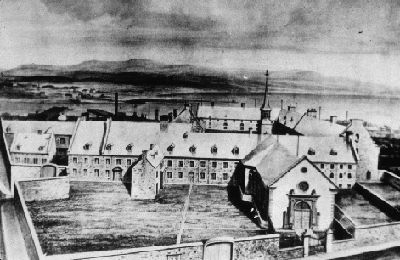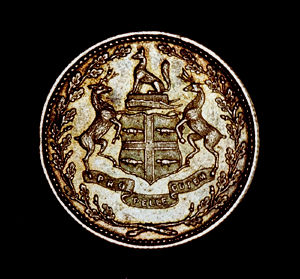Browse "New France"
-
Article
Fur Trade Route Networks
Throughout the period of the historical fur trade (early 17th to the mid-19th century), water routes were the natural “highways” of First Nations trappers and European fur traders. Water trading networks connected Indigenous societies from the Atlantic Ocean, along the St. Lawrence River to the Great Lakes, and then on towards the Hudson Bay watershed. North America’s waterborne geography facilitated intracontinental travel, enabled European expansion and settlement into Indigenous North America, and shaped the contours of Euro-Indigenous relations in the context of the fur trade. These extensive and interconnected systems of rivers, lakes and overland trails criss-crossed Indigenous territories and had been used for generations. At the height of the fur trade, the principal canoe route extended westward from the Island of Montreal through the Great Lakes, and from the northwestern shore of Lake Superior over the height of land into the Hudson Bay watershed. From the Lake Winnipeg basin, Indigenous trappers and European traders fanned out towards the Western Prairies via the Assiniboine, Qu’Appelle and Souris rivers, towards the foothills of the Rocky Mountains via the North and South branches of the Saskatchewan River, and finally towards the Athabasca Country via the Sturgeon-weir River and the Methye Portage.
"https://d2ttikhf7xbzbs.cloudfront.net/media/media/6a52818a-3f78-427a-a201-5e6bc9c5d874.jpg" // resources/views/front/categories/view.blade.php
https://d2ttikhf7xbzbs.cloudfront.net/media/media/6a52818a-3f78-427a-a201-5e6bc9c5d874.jpg
-
Article
Gouverneur
The governor of New France was the king’s official representative in the colony and the commander of military forces. He was also in charge of diplomatic relations with Indigenous peoples and other colonies.
"https://d2ttikhf7xbzbs.cloudfront.net/media/media/e7085521-d659-41d4-abc9-956dc653cc22.jpg" // resources/views/front/categories/view.blade.php
https://d2ttikhf7xbzbs.cloudfront.net/media/media/e7085521-d659-41d4-abc9-956dc653cc22.jpg
-
Article
High Wines
Liquor adulterated for use in the fur trade. Fur traders who supplied liquor to the natives often diluted their brandy, rum, whisky, etc, with flavoured water. The term "high wines" is a misnomer, for the trade goods are not wines but spirits.
"https://development.thecanadianencyclopedia.ca/images/tce_placeholder.jpg?v=e9dca980c9bdb3aa11e832e7ea94f5d9" // resources/views/front/categories/view.blade.php
https://development.thecanadianencyclopedia.ca/images/tce_placeholder.jpg?v=e9dca980c9bdb3aa11e832e7ea94f5d9
-
Article
Hôtel-Dieu
Hôtel-Dieu is the name given to hospitals established by nursing orders of nuns. The Hôtel-Dieu de Montréal was founded by Jeanne Mance and funded by Madame de Bullion, the widow of one of Louis XIII's superintendents of finance.
"https://d2ttikhf7xbzbs.cloudfront.net/media/media/6281323c-92e7-4ded-9b6d-ada01d788513.jpg" // resources/views/front/categories/view.blade.php
https://d2ttikhf7xbzbs.cloudfront.net/media/media/6281323c-92e7-4ded-9b6d-ada01d788513.jpg
-
Article
Hudson’s Bay Point Blanket
The Hudson’s Bay Point Blanket is a wool blanket with a series of stripes and points (markers on cloth) first made for the Hudson’s Bay Company (HBC) in 1779. The most iconic design is that which is white with green, red, yellow and indigo stripes; these colours are now used as an emblem for the HBC. While the HBC was not the first to create the point blanket, the company did popularize it among Indigenous and settler communities in Canada. Today, the design from the blanket is used on a variety of clothing, accessories and household items sold by the HBC.
"https://d2ttikhf7xbzbs.cloudfront.net/media/new_article_images/HBCpointblanket/HBC point blanket (2).jpg" // resources/views/front/categories/view.blade.php
https://d2ttikhf7xbzbs.cloudfront.net/media/new_article_images/HBCpointblanket/HBC point blanket (2).jpg.jpg)
-
Article
King's Posts
King's Posts, a name applied during the French regime to fur trade and fishing posts in the King's Domain.
"https://development.thecanadianencyclopedia.ca/images/tce_placeholder.jpg?v=e9dca980c9bdb3aa11e832e7ea94f5d9" // resources/views/front/categories/view.blade.php
https://development.thecanadianencyclopedia.ca/images/tce_placeholder.jpg?v=e9dca980c9bdb3aa11e832e7ea94f5d9
-
Article
King's Presents
The practice of offering regular gifts to Indigenous trading partners and allies, begun by Governor Montmagny in 1648, was, by the end of the 17th century institutionalized as the "Présents du Roy" at the annual meeting with the governor-general of New France at Montréal.
"https://development.thecanadianencyclopedia.ca/images/tce_placeholder.jpg?v=e9dca980c9bdb3aa11e832e7ea94f5d9" // resources/views/front/categories/view.blade.php
https://development.thecanadianencyclopedia.ca/images/tce_placeholder.jpg?v=e9dca980c9bdb3aa11e832e7ea94f5d9
-
Editorial
Cavelier de La Salle: French Explorer
The following article is an editorial written by The Canadian Encyclopedia staff. Editorials are not usually updated.
"https://development.thecanadianencyclopedia.ca/images/tce_placeholder.jpg?v=e9dca980c9bdb3aa11e832e7ea94f5d9" // resources/views/front/categories/view.blade.php
https://development.thecanadianencyclopedia.ca/images/tce_placeholder.jpg?v=e9dca980c9bdb3aa11e832e7ea94f5d9
-
Article
Made Beaver
Hudson's Bay Company found it necessary to devise a unit of value that would accommodate Aboriginal people's bartering to European bookkeeping methods
"https://d2ttikhf7xbzbs.cloudfront.net/media/media/3de41ff0-80b9-44c7-b85a-1bb3d3054580.jpg" // resources/views/front/categories/view.blade.php
https://d2ttikhf7xbzbs.cloudfront.net/media/media/3de41ff0-80b9-44c7-b85a-1bb3d3054580.jpg
-
Article
Mer de l'Ouest
Mer de l'Ouest ("Western Sea"), originally the goal of exploration during the French regime, was the stuff of wishful thinking obligingly corroborated by Indians. Initially thought to be an inland sea somewhere west of the Great Lakes, it gradually blended in imagination with the Pacific.
"https://development.thecanadianencyclopedia.ca/images/tce_placeholder.jpg?v=e9dca980c9bdb3aa11e832e7ea94f5d9" // resources/views/front/categories/view.blade.php
https://development.thecanadianencyclopedia.ca/images/tce_placeholder.jpg?v=e9dca980c9bdb3aa11e832e7ea94f5d9
-
Article
New France
The history of France as a colonial power in North America began during the 16th century, during the era of European exploration and fishing expeditions. At its peak, the French colony of New France stretched over a vast area from the Gulf of St. Lawrence to Louisiana. The French presence was characterized by extensive trade, as well as by recurrent conflicts with the Indigenous peoples, who were established over a wide area that France sought to appropriate. Some objectives motivating the French colonization were related to evangelization and settlement. Following the British Conquest, New France was ceded to Great Britain in 1763 and became a British colony. (See Treaty of Paris 1763.) (This article is the full version of the text regarding New France. For a plain-language summary, please see New France (Plain Language Summary).)
"https://d2ttikhf7xbzbs.cloudfront.net/media/media/d698c031-e790-4c17-906a-5b880e71e24d.jpg" // resources/views/front/categories/view.blade.php
https://d2ttikhf7xbzbs.cloudfront.net/media/media/d698c031-e790-4c17-906a-5b880e71e24d.jpg
-
Article
Ordre de Bon Temps
Ordre de Bon Temps ("Order of Good Cheer"), was founded at Port-Royal in 1606 by Samuel de Champlain .
"https://d2ttikhf7xbzbs.cloudfront.net/media/media/eae4b142-cd6b-4c86-a303-32da3140b207.jpg" // resources/views/front/categories/view.blade.php
https://d2ttikhf7xbzbs.cloudfront.net/media/media/eae4b142-cd6b-4c86-a303-32da3140b207.jpg
-
Article
Pays d'en Haut
Pays d'en Haut [French "up country" or "upper country"] was an expression used in the fur trade to refer to the area to which the voyageurs travelled to trade.
"https://d2ttikhf7xbzbs.cloudfront.net/GreatLakesNewFrance.jpg" // resources/views/front/categories/view.blade.php
https://d2ttikhf7xbzbs.cloudfront.net/GreatLakesNewFrance.jpg
-
Article
Playing-Card Money
Playing-card money was a type of paper money used periodically in New France from 1685 to the British Conquest in 1763. Playing cards issued by the king — later replaced with white cards cut to various shapes — held values equivalent to French livres.
"https://d2ttikhf7xbzbs.cloudfront.net/media/media/f1733c26-ebb9-45c6-be6b-aecf8c7a9503.jpg" // resources/views/front/categories/view.blade.php
https://d2ttikhf7xbzbs.cloudfront.net/media/media/f1733c26-ebb9-45c6-be6b-aecf8c7a9503.jpg
-
Article
Revue d'histoire de l'Amérique française
La Revue d'histoire de l'Amérique française was founded in 1947 by Lionel GROULX, professor of history at U de Montréal.
"https://d2ttikhf7xbzbs.cloudfront.net/media/media/6e559a82-fa39-4e67-8505-cd188e83d9d0.jpg" // resources/views/front/categories/view.blade.php
https://d2ttikhf7xbzbs.cloudfront.net/media/media/6e559a82-fa39-4e67-8505-cd188e83d9d0.jpg
